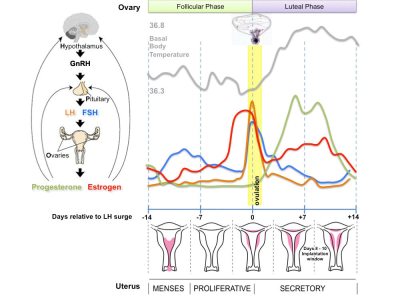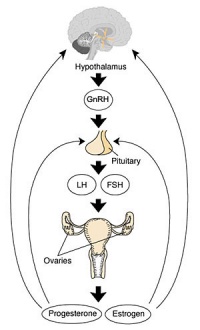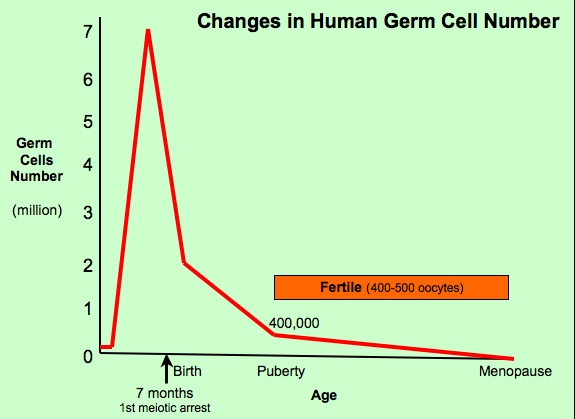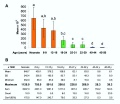Menstrual Cycle
Introduction
The human reproductive cycle, an cyclic endocrine regulated change in female anatomy and physiology that occur over 28 days (4 weeks, a lunar month) during reproductive life (between puberty and menopause). Endocrine changes during pregnancy block the menstrual cycle, which normally would shed the functional layer of the uterine lining each cycle. A common misunderstanding is that development of the follicles occurs within a single cycle, in fact humans require at least 3 menstrual cycles to occur in the development of an ovulating follicle.
This cycle differs from other non-primate female vertebrates (eg rats, mice, horses, pig) that have a reproductive cycle called the estrous cycle (oestrous, British spelling).
- The average menstrual cycle is 28 days with ovulation (egg release) occuring approximately the middle of the cycle.
- The last menstrual period (LMP) is used clinically in determining developmental ages. (More Birth Date)
- Menstruation phase (menses, period) is the loss of the uterus epithelial functional layer and occurs if fertilization and implantation have not occurred before the end of the current cycle.
Menstrual Parameters
There is a broad variability in the parameters of the adult human menstrual cycle. The data below is based upon normal mid-reproductive years and using simplified terminology, Table IV from 2007 international agreement discussion.[1] The same group also recommended replacing confusing clinical terms such as amenorrhea, menorrhagia, metrorrhagia, hypermenorrhea and dysfunctional uterine bleeding.
| Clinical dimensions of menstruation and menstrual cycle | Descriptive terms | Normal limits (5th - 95th percentiles) |
| Frequency of menses (days) | Frequent | < 24 |
| Normal | 24 - 38 | |
| Infrequent | > 38 | |
| Regularity of menses (cycle to cycle variation over 12 months; in days) | Absent | - |
| Regular | Variation ± 2 to 20 days | |
| Irregular | Variation greater than 20 days | |
| Duration of flow (days) | Prolonged | > 8.0 |
| Normal | 4.5 - 8.0 | |
| Shortened | < 4.5 | |
| Volume of monthly blood loss (ml)[2] | Heavy | > 80 |
| Normal | 5 - 80 | |
| Light | < 5 |
Environmental Effects
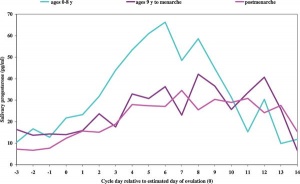
A recent paper has also demonstrated that the human menstral cycle can be modulated postnatally by environmental conditions as measured by changes in progesterone based upon the age of migration from a relatively poor environment (Bangladesh) to a relatively better environment (UnitedKingdom).[3]
Menstrual Cycle Histology

The different stages of the menstrual cycle can be monitored by the cellular appearance of vaginal smears Menstrual Cycle - Histology.
A more invasive technique is dilate and curettage (DnC), which allows sampling of the functional layer of the uterine endometrium Menstrual Cycle - Histology.
Ovulation (HPG Axis)
- Hypothalmus releases gonadotropin releasing hormone (GRH, luteinizing hormone–releasing hormone, LHRH) -> Pituitary releases follicle stimulating hormone (FSH) and lutenizing hormone (LH) -> ovary follicle development and ovulation.
- release of the secondary oocyte and formation of corpus luteum
- secondary oocyte encased in zona pellucida and corona radiata
- Ovulation associated with follicle rupture and ampulla movement
Ovulation Movies
Human Oocyte Numbers
There is continuing debate as to whether the human ovary has the ability to generate, or continues to generate, new functional follicles and oocytes postnatally.[4] [5] (More? Ovary Development)
- The graph shows the changes in human germ cell numbers in the ovary with age, peaking at about 7 million (occuring in early fetal development) and then decreasing by apopotic cell death.
- At puberty there remain only about 400,000 and only about 10% of these will be released through reproductive life.
- Graph based on data from: Hassold, etal., Environ Mol Mutagen 1996. 28: 167-175
Follicle Development
A common misunderstanding is that development of the follicle containing the oocyte occurs within a single cycle. In fact humans require at least 3 menstrual cycles to occur in the development of a single ovulating follicle. Most of the other follicles will degenerate in a process described as atresia.
Oocyte Development
Primary Oocyte
- arrested at early Meiosis 1
- diploid: 22 chromosome pairs + 1 pair X chromosomes (46, XX) autosomes and sex chromosome
- Oogenesis- pre-antral then antral follicle (Graafian follicle is mature antral follicle released)
Secondary Oocyte
- 1 Day before ovulation completes (stim by LH) Meiosis 1
- haploid: 22 chromosomes + 1 X chromosome (23, X)
- nondisjunction- abnormal chromosome segregation
- begins Meiosis 2 and arrests at metaphase
- note no interphase replication of DNA, only fertilization will complete Meiosis 2
References
- ↑ Can we achieve international agreement on terminologies and definitions used to describe abnormalities of menstrual bleeding? Fraser IS, Critchley HO, Munro MG, Broder M. Hum Reprod. 2007 Mar;22(3):635-43. Epub 2007 Jan 4. PMID: 17204526 | Hum Reprod.
- ↑ Menstrual blood loss--a population study. Variation at different ages and attempts to define normality. Hallberg L, Högdahl AM, Nilsson L, Rybo G. Acta Obstet Gynecol Scand. 1966;45(3):320-51. PMID: 5922481
- ↑ Childhood conditions influence adult progesterone levels. Núñez-de la Mora A, Chatterton RT, Choudhury OA, Napolitano DA, Bentley GR. PLoS Med. 2007 May;4(5):e167. PMID: 17503960 | PLoS Medicine
- ↑ Origin of germ cells and formation of new primary follicles in adult human ovaries. Bukovsky A, Caudle MR, Svetlikova M, Upadhyaya NB. Reprod Biol Endocrinol. 2004 Apr 28;2:20. PMID: 15115550
- ↑ The oocyte population is not renewed in transplanted or irradiated adult ovaries. Begum S, Papaioannou VE, Gosden RG. Hum Reprod. 2008 Oct;23(10):2326-30. Epub 2008 Jul 1. PMID: 18596027
Reviews
- The primordial pool of follicles and nest breakdown in mammalian ovaries. Tingen C, Kim A, Woodruff TK. Mol Hum Reprod. 2009 Dec;15(12):795-803. Epub 2009 Aug 26. Review. PMID: 19710243 | Mol Hum Reprod.
Articles
- Effect of rising hCG levels on the human corpus luteum during early pregnancy. Järvelä IY, Ruokonen A, Tekay A. Hum Reprod. 2008 Dec;23(12):2775-81. PMID: 18694877
Search Pubmed
Search Pubmed Now: Menstrual Cycle | corpus luteum
Additional Images
External Links
Women’s Health Queensland Wide - Understanding Your Menstrual Cycle
Glossary Links
- Glossary: A | B | C | D | E | F | G | H | I | J | K | L | M | N | O | P | Q | R | S | T | U | V | W | X | Y | Z | Numbers | Symbols | Term Link
Cite this page: Hill, M.A. (2024, May 5) Embryology Menstrual Cycle. Retrieved from https://embryology.med.unsw.edu.au/embryology/index.php/Menstrual_Cycle
- © Dr Mark Hill 2024, UNSW Embryology ISBN: 978 0 7334 2609 4 - UNSW CRICOS Provider Code No. 00098G
